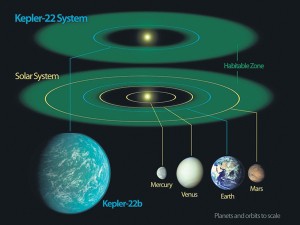2011’s notable scientific events, health breakthroughs
As the year bids farewell, let us look back on some of the most notable scientific events and health breakthroughs that defined 2011.

This Nasa artist’s illustration shows Kepler-22b, a planet known to circle the habitable zone of a sun-like star. In another step toward finding Earth-like planets that may hold life, Nasa said the Kepler space telescope had confirmed its first-ever planet in a habitable zone outside our solar system. Confirmation means that astronomers have seen it crossing in front of its star three times. But it doesn’t mean that astronomers know whether life actually exists there, simply that the conditions are right. AFP
Planet Kepler-22b discovered
Think of the alien moon Pandora in the James Cameron’s blockbuster movie Avatar. As the first confirmed planet that resembles ours, scientists are hopeful it may harbor life.
The discovery was announced months after Kepler, an orbiting Nasa (National Aeronautics and Space Administration) space telescope, discovered a new system of planets in February 2011.
After months of intense observation, scientists have finally confirmed the presence of planet Kepler-22b, the smallest yet found to orbit in the middle of the habitable zone of a star similar to our sun.
The planet is about 2.4 times the radius of Earth and orbits a sun-like star for 290 days.
Article continues after this advertisementWhile scientists don’t yet know if Kepler-22b has a predominantly rocky, gaseous or liquid composition, its discovery is a step closer to finding Earth-like planets.
Article continues after this advertisementBut to get there, one needs to travel at the speed of light for about 600 years.
Vaccine for malaria
With around 800,000 people dying and with millions more sickened, the announcement that a vaccine against malaria is almost at hand is certainly great news.
The hopeful candidate, which is called “RTS,S” is in a phase three trial involving more than 15,000 children in seven African countries. This is the farthest any malaria vaccine has come: just one stage from possible approval for widespread use.
Scientists at a Seattle laboratory have been dissecting around 200 mosquitoes for the vaccine an hour and are learning how to make it safer, and learn to manufacture it on a larger scale.
Advances have been made with wide distribution of insecticide-treated bednets and greater access to malaria drugs. But fear of resistance to anti-malarial medications is increasing, and the drugs are only prescribed after a patient contracts the disease. A vaccine would do the opposite by seeking to prevent infection in the first place.
In the case of RTS,S, preliminary results just released from 6,000 of the children in the trial—all between the ages of five months and 17 months—showed about a 50-percent drop in cases.
Wish upon a falling star
Wishes must have come true for a lot of individuals last week as Geminid meteor shower intensified on the nights of Dec. 13 and 14.
The Geminids are one of 2011’s best annual meteor showers.
On a dark, moonless night, the Geminids often produce 50 or more meteors per hour, or nearly a meteor a minute. However, this year, the moon shone bright and observers had to settle for a single bright meteor or two.
Last chance
It was a tough night for stargazers around the country as clouds almost succeeded in obscuring the second as well as last total lunar eclipse this year.
This rare event—those who missed the event will have to wait until April 2014—occurs when the Moon, in its orbit around the Earth, passes into the Earth’s shadow, as cast by the Sun.
The moon turned copper-red as the Earth’s shadow falls on it, an occurrence that has had astronomy enthusiasts excited particularly because the eclipse took place soon after sunset.
Efficient and hardy plant
Dutch company PlantLab announced it has figured out how to triple the yield of plants using only artificial light and 10 percent of the water typically needed.
The plant, grown indoor, only needs a correct balance of colored LED light, thus increasing photosynthesis efficiency between 12 and 15 percent (via sunlight, it’s only 9 percent efficient).
PlantLab says that double the efficiency means increased yield (or more likely equal yield with less energy). By keeping the plants in a contained system, PlantLab can also recycle evaporated water, which helps them grow crops using just one tenth the water as with traditional greenhouses.
Pesticide is no longer needed as plants are grown indoors and PlantLab said its production facilities can be built almost anywhere: from the deserts of Sahara to the icy plains of the Artic.
With PlantLab’s discovery, everyone’s food can be grown as local as possible, which means fresher food with less costs of transportation.